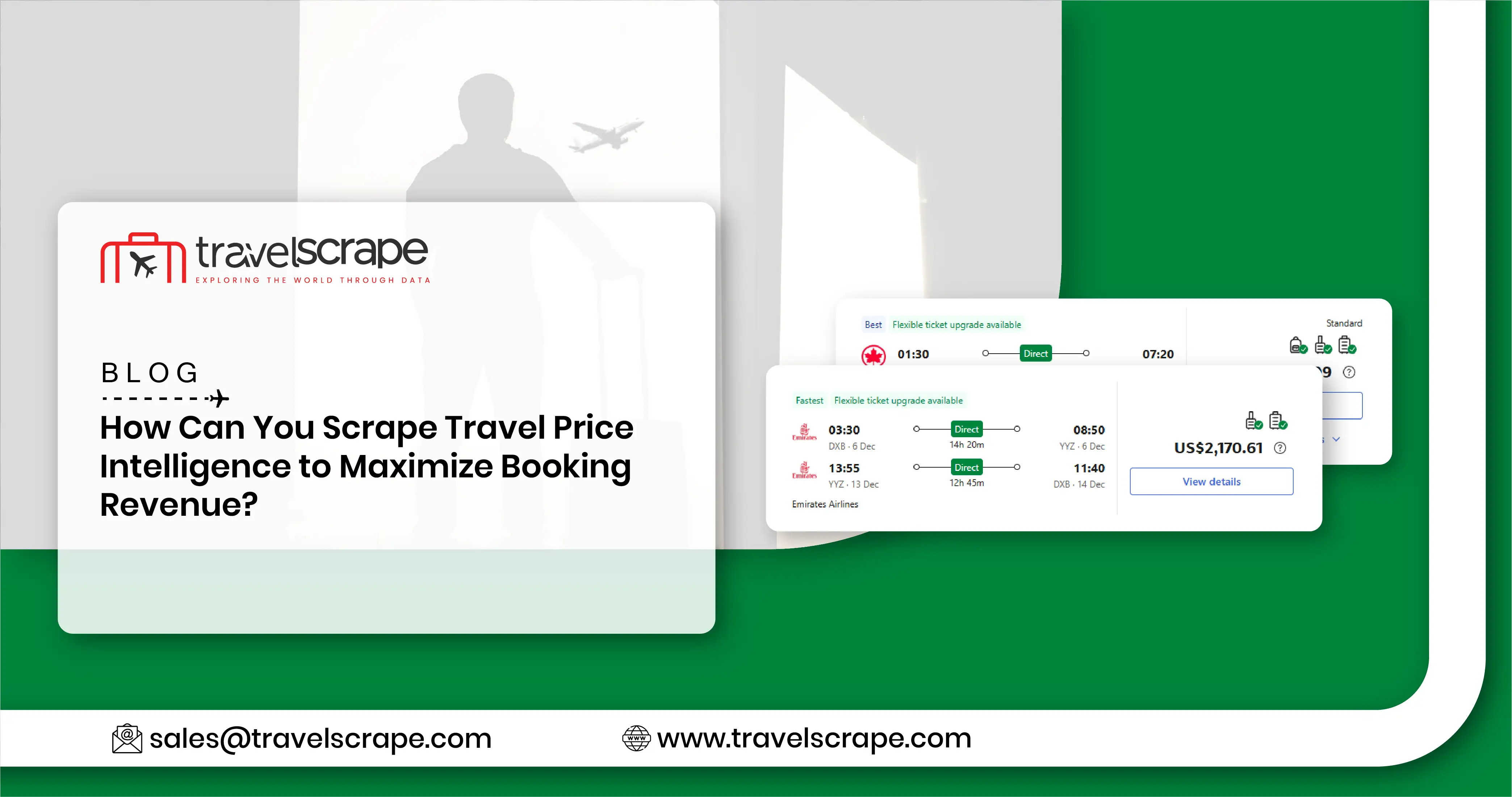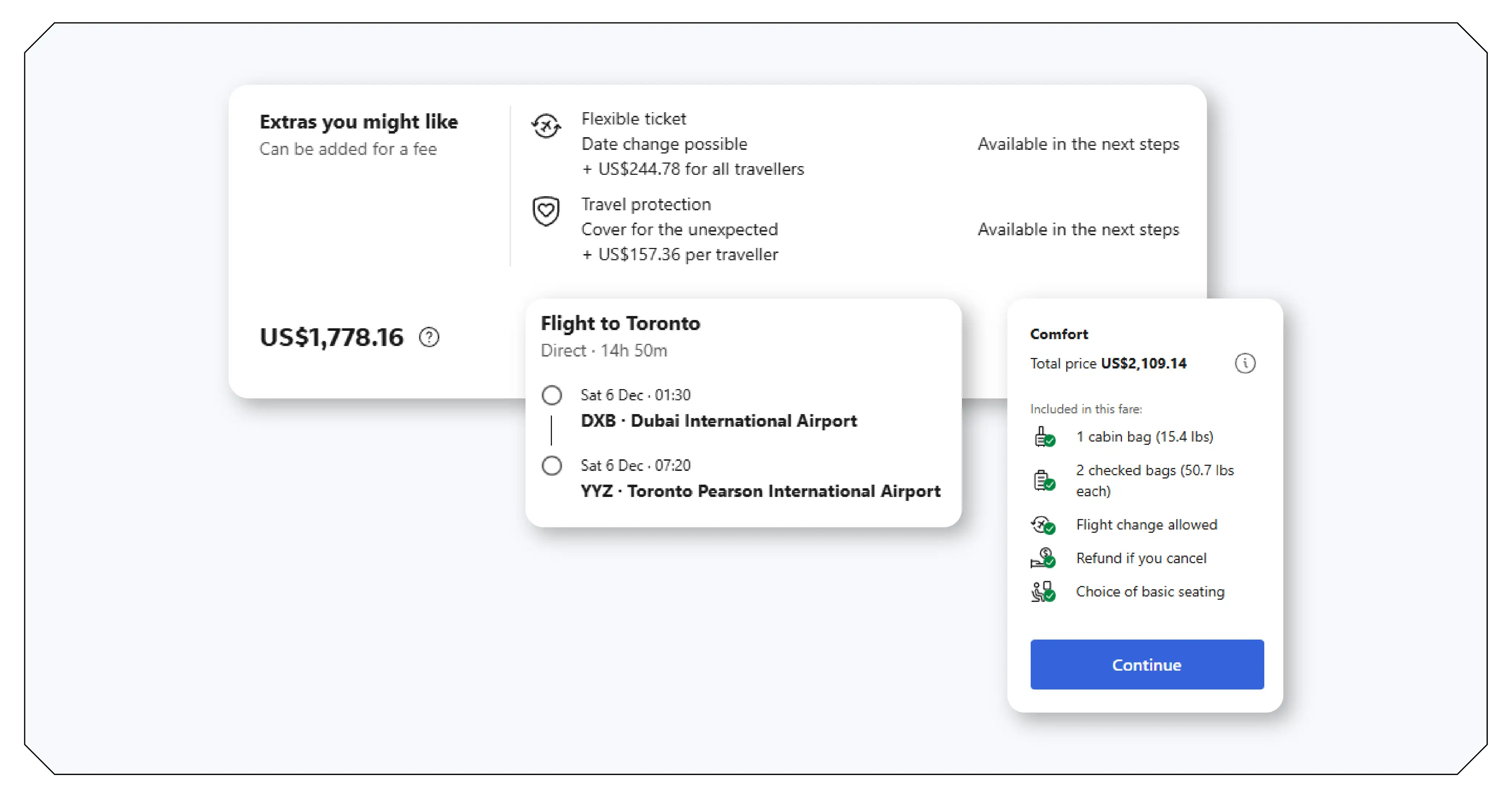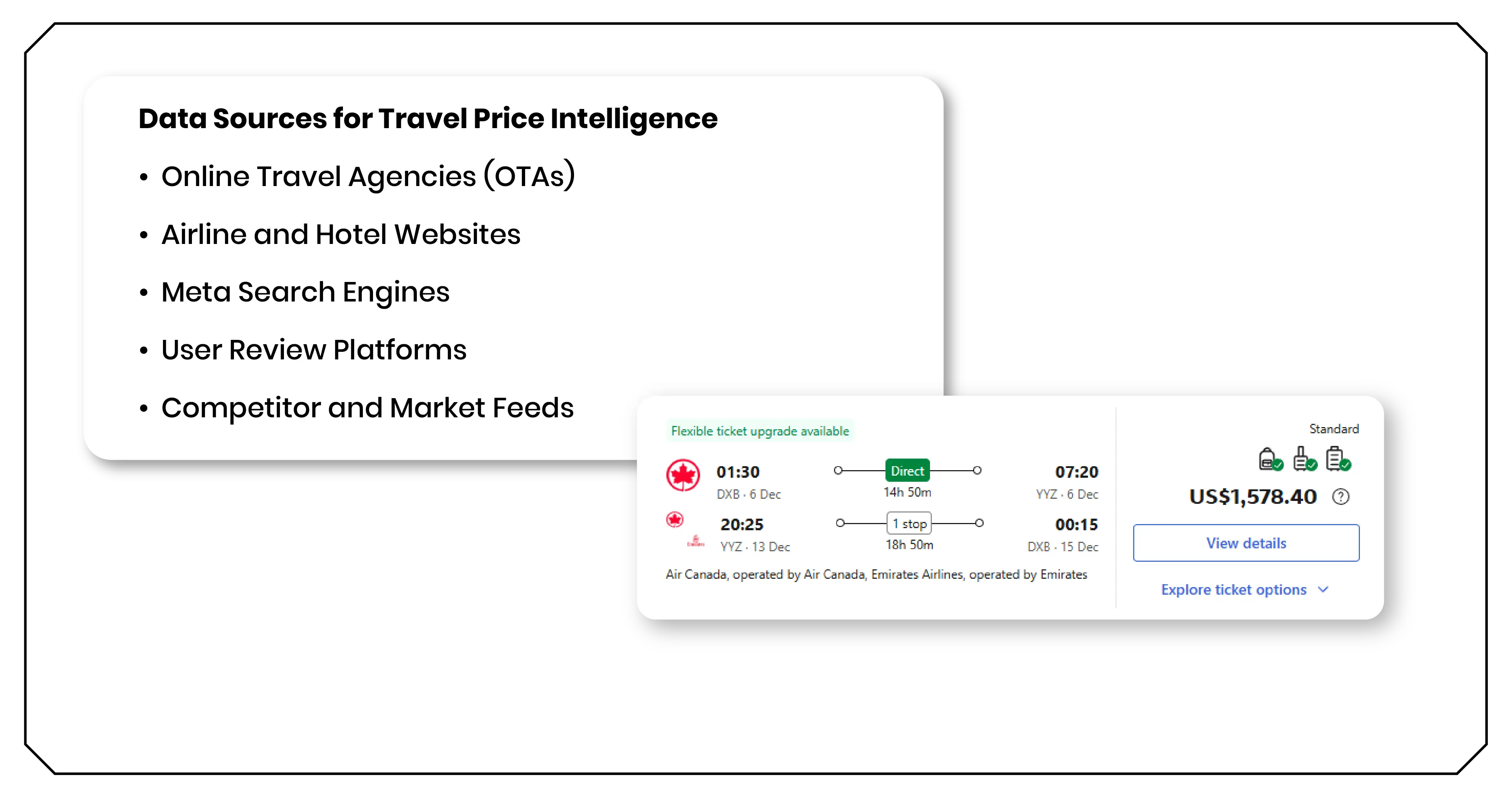How Can You Scrape Travel Price Intelligence to Maximize Booking Revenue?

Introduction
In today’s dynamic tourism economy, where traveler preferences shift daily and airline or hotel prices fluctuate by the minute, businesses need to go beyond guesswork to maintain profitability. Harnessing strategy to Scrape Travel Price Intelligence empowers travel brands, OTAs, and booking platforms to transform massive amounts of real-time price data into actionable insights. When complemented with Travel & Tourism Datasets, this approach enables more accurate demand forecasting, competitive pricing, and better inventory allocation strategies. By integrating Real-time scraped price data Intelligence, travel businesses can detect pricing trends, identify market gaps, and make data-backed decisions that elevate both revenue and customer satisfaction.
Understanding the Power of Travel Price Intelligence

Travel Price Intelligence is the process of analyzing scraped, aggregated, and structured travel data to forecast demand, optimize prices, and monitor competitor movements. It involves extracting live pricing, availability, and booking data from multiple sources such as airline websites, hotel aggregators, OTAs, and meta-search engines. This comprehensive view allows companies to understand market dynamics and respond proactively rather than reactively.
Traditional travel pricing models relied heavily on historical trends or static fare structures. However, with the evolution of Travel Data Intelligence Tourism, businesses can now integrate real-time datasets into machine learning models to predict future demand surges, flight fare drops, or hotel price hikes. This predictive capability forms the foundation for dynamic pricing systems and helps businesses ensure competitive advantage while maximizing profits.
The Role of Real-Time Scraped Data in Forecasting Demand
Real-time data scraping revolutionizes how travel companies analyze and forecast consumer behavior. Through advanced crawlers and APIs, brands can monitor millions of data points — from hotel rates and flight availability to local event impacts and seasonal price spikes.
Using this approach, companies can Extract Travel booking Price Data from OTAs such as Expedia, Booking.com, Agoda, and MakeMyTrip to study trends in customer demand, booking windows, and price sensitivity. For instance, scraped datasets can reveal that travelers tend to book weekend trips at higher prices or prefer budget accommodations during off-peak seasons. By leveraging this data, travel agencies can adjust marketing campaigns, promotions, and inventory distribution accordingly.
Moreover, such datasets can track competitive pricing fluctuations in real time, giving travel companies an upper hand in adjusting their prices dynamically. Airlines, for example, use scraped fare data to adjust flight ticket prices within hours based on competitor behavior or occupancy levels. This real-time responsiveness is key to maintaining optimal booking margins and customer loyalty.
Combining Price, Availability, and Booking Pattern Data
When pricing data is merged with availability and booking behavior, businesses gain a 360° view of market performance. This integration enables predictive analytics models that can anticipate future travel trends, assess the elasticity of demand, and optimize revenue.
Travel Price Intelligence for Dynamic Pricing plays a vital role in aligning travel product offerings with customer willingness to pay. For instance, a hotel chain can analyze scraped availability data to detect low-occupancy days and introduce last-minute discounts, while simultaneously raising rates during high-demand events or holidays. Airlines can do the same by cross-referencing booking pace and seat availability.
Dynamic pricing models powered by Travel Price Intelligence are built upon real-world parameters — past sales data, current search volumes, seasonal events, and competitor price shifts. When all these factors are combined, predictive models generate price recommendations that balance competitiveness with profitability.
This data-driven ecosystem not only improves revenue but also enhances user experience by offering transparent, adaptive pricing options that reflect real-time market conditions.
Real-World Use Cases of Travel Price Intelligence
- Dynamic Pricing Tools
Modern travel platforms integrate Dynamic Travel Price Tracking Tools to adjust their rates automatically. Airlines like Ryanair or hotels on Booking.com utilize data-driven algorithms that respond to fluctuations in demand, competitor prices, and local events. This ensures that customers always see relevant prices while businesses maintain their profit margins. - Budget Trackers for Travelers
Travelers increasingly rely on fare tracking tools that notify them when prices drop for specific routes or hotels. These budget-tracking applications use scraped travel datasets and analytics engines to identify pricing trends, forecast optimal booking times, and alert users accordingly. This transparency builds trust between travelers and booking platforms. - Travel Planning Applications
Predictive analytics powers the backend of many travel planning apps that combine pricing, reviews, and availability data. By using Travel Market Data for Pricing Intelligence, these applications help users make cost-effective decisions, compare multi-platform deals, and book at the best times. - Revenue Optimization Systems for OTAs and Airlines
Online travel agencies and airlines integrate data from multiple sources into their revenue management systems. Through this approach, they can forecast load factors, evaluate booking curves, and make timely decisions regarding promotions and route adjustments. - Destination and Demand Forecasting Models
Government tourism departments and destination marketers are leveraging scraped travel datasets to assess tourist inflows, popular routes, and seasonal travel trends. This data-driven insight enables them to enhance infrastructure planning, marketing campaigns, and traveler experience design.
Data Sources for Travel Price Intelligence

A reliable data-driven travel pricing strategy depends on quality datasets. Common data sources include:
- Online Travel Agencies (OTAs): Platforms like Expedia, Agoda, and MakeMyTrip provide valuable data on pricing and availability.
- Airline and Hotel Websites: Direct scraping from supplier websites helps detect live inventory changes.
- Meta Search Engines: Platforms like Skyscanner and Google Flights aggregate vast amounts of fare and availability data.
- User Review Platforms: Analyzing review sentiment can identify pricing influence factors such as service quality and satisfaction levels.
- Competitor and Market Feeds: Comparing competitor rates in real time ensures more strategic pricing moves.
These sources, when combined, feed advanced analytics systems that continuously learn and evolve based on changing market conditions.
Transforming the Travel Industry Through Data
The travel sector is rapidly evolving into a digital-first ecosystem. Transforming Travel Intelligence means redefining how data is collected, analyzed, and utilized for smarter decision-making. With AI and automation, data extraction tools can track global pricing behavior within seconds, offering unprecedented agility to both travel operators and consumers.
By transforming raw scraped data into structured insights, companies gain a competitive advantage. They can anticipate high-demand periods, optimize marketing campaigns, and craft personalized travel experiences. Whether it’s predicting the next travel trend or determining the most profitable pricing model, Travel Price Intelligence enables smarter, more agile business strategies across the tourism landscape.
Benefits of Adopting a Data-Driven Travel Pricing Strategy
- Increased Revenue Margins: Automated and data-backed pricing adjustments reduce underpricing and improve profit margins.
- Improved Demand Prediction: Real-time tracking helps anticipate seasonal or event-based surges.
- Enhanced Customer Experience: Personalized pricing and recommendations based on user behavior improve satisfaction.
- Reduced Revenue Leakage: Continuous monitoring ensures quick response to market fluctuations.
- Strategic Positioning: With accurate pricing benchmarks, travel brands can strengthen their competitive stance.
The Future of Travel Pricing: AI and Predictive Analytics
AI-powered predictive models represent the next leap in travel price optimization. With machine learning, travel brands can forecast not only prices but also customer intent. Integrating scraping tools with neural network-based models can detect micro-trends—like last-minute trip spikes or weekday vs. weekend preferences—and use them to refine marketing and pricing strategies.
As technology evolves, businesses that leverage Travel Price Intelligence will have the agility to adapt instantly to market changes, ensuring resilience and profitability even in uncertain conditions.
How Travel Scrape Can Help You?
- Accurate Price Tracking:
We help you gather and monitor real-time pricing data from airlines, hotels, and travel portals, ensuring that you stay informed about competitor rates and market fluctuations. - Enhanced Demand Prediction:
Our scraping solutions enable you to identify booking trends, peak travel periods, and customer behavior patterns, helping your business forecast demand more accurately. - Smarter Revenue Optimization:
By combining pricing, availability, and booking data, we allow you to implement dynamic pricing models that maximize revenue while maintaining competitive pricing. - Comprehensive Market Insights:
Our data extraction services provide valuable insights into regional trends, traveler preferences, and market performance, empowering better decision-making for marketing and operations. - Seamless Data Integration:
We deliver structured travel data through easy-to-use APIs and custom dashboards, allowing your team to integrate insights directly into internal systems for faster strategic action.
Conclusion
Travel businesses that embrace data-driven models stand to benefit immensely from automated decision-making, enhanced forecasting, and more informed pricing strategies. By integrating Web Scraping for Travel Demand Prediction, companies can capture the pulse of the global travel market and anticipate shifts before competitors do. Leveraging Travel Price Tracking and Forecasting API empowers platforms to synchronize price intelligence with booking behavior in real time. Ultimately, the integration of Travel Data Intelligence Solutions ensures sustainable growth, smarter customer engagement, and a clear competitive edge in the evolving travel ecosystem.
Ready to elevate your travel business with cutting-edge data insights? Scrape Aggregated Flight Fares to identify competitive rates and optimize your revenue strategies efficiently. Discover emerging opportunities with tools to Extract Travel Website Data, leveraging comprehensive data to forecast market shifts and enhance your service offerings. Real-Time Travel App Data Scraping Services helps stay ahead of competitors, gaining instant insights into bookings, promotions, and customer behavior across multiple platforms. Get in touch with Travel Scrape today to explore how our end-to-end data solutions can uncover new revenue streams, enhance your offerings, and strengthen your competitive edge in the travel market.